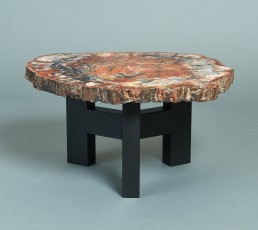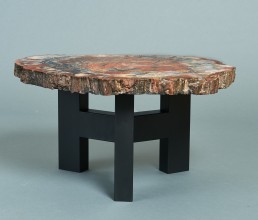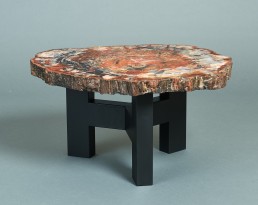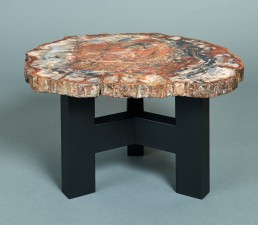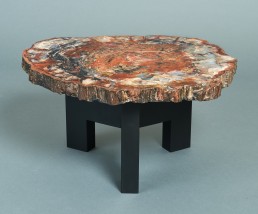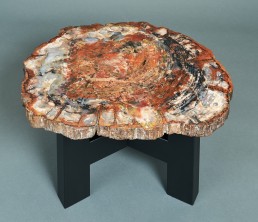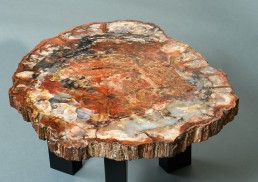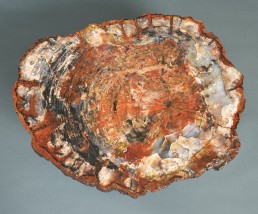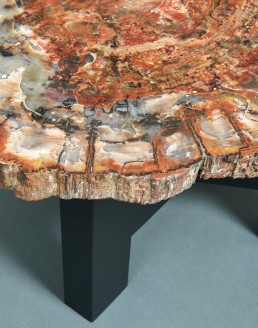Ado Chale: Rare and Exceptional Coffee Table in Petrified Wood and Steel, Belgium c. 1968
Ado Chale (b. 1928)
An early and exceptional organic coffee table by Ado Chale. Chale’s iconic tripod base, in enameled steel, supports a gleaming cross section of petrified Arizona sequoia, dating back some 200 million years. Cleaved from a fossilized tree trunk Chale discovered during his gemological travels in the Arizona desert, it was carefully sliced to elevate the most beautiful patterns, then diamond polished to a deep, lustrous sheen. In vibrant rust hues speckled with burnt umbers and translucent clouds of gray, the table evokes an aurora borealis. As no cross section is like any other, each of these early works is unique. A masterwork of proportion, color, and balance, this table is one of the most beautiful, true, and poetic of Chale’s creations.
Belgium, c. 1968
14″ H x 25″ L x 21.25″ D
- Origin: Belgium
- Period: c. 1968
- Dimensions: 14" H x 25" L x 21.25" D
- Materials: Petrified wood, enameled steel
- Condition: Excellent
Product Description
https://aparte-editions.be/livres/ado-chale
One at $35,000 at Lobel Modern in NY
List mine at $29,000
enameled steel tripod base
Les matériaux qu’il utilise tels que malachite, cornaline et jaspe sont si fragiles et rares qu’ils font de chaque création une œuvre unique.
ADO CHALE (Belge, 1928) Table d’appoint / Side table
Plateau en séquoia fossilisé d’Arizona sur piètement en bois, France, ca 1970 H 36 x L 63 x P 54 cm (14″ H x 25″ L x 21.25″ D
H 33.02 cm x W 68.58 cm x D 60.96 cm
H 13 x 27 x 24
Extraordinary coffee table incorporating a polished fossilized wood top with jewel tones on a metal base by Ado Chale, Belgium, 1960s.
This two-piece table is a hallmark of Chale’s work. Born Adolphe Pelsener on March 18, 1928 in Brussels, Belgium where he currently lives and works Chale opened his first gallery in 1962. He exhibited jewelry and small side tables adorned with his unique inlay and sourced various gems and rocks via international travel. The self-taught craftsman then incorporated his acquisitions into larger pieces of furniture and sculptures attractive for their beauty and novelty in the 1970s. His furniture and domestic objects reference the natural world not only through the use of precious stones, metals, and organic materials, but also through the textures, patterns, and forms they express. Ado Chale’s works have been displayed in several museums – World Exhibition in Montreal; Musée des Beaux Arts in Nancy, France; Musée Galliera in Paris. His pieces can be found in several notable private collections, among them Liliane Bettencourt, British royalty, and King Saud of Saudi Arabia.
This table is 1 of 3 made. The stone is Rhodochrosite. Ado Chale is a Belgian artist and designer best known for his exquisite mosaic inlays. Pieces of wood, minerals, or bone are sliced, arranged, and coated with resin to form the opulent surfaces. His furniture and domestic objects reference the natural world not only through the use of precious stones, metals, and organic materials, but also through the textures, patterns, and forms they express.
An early and exceptional coffee table by Ado Chale This rare piece is an exceptional early work by Chale, in a model no longer produced.
rare of a model no longer in production
Each piece is unique, as no two fossilized wood specimens are the same.
Ado Chale developed his passion for minerals in the mid 1950s, while traveling in Germany. In 1966, he opened a small shop in Brussels, selling rare and beautiful mineral specimens. Coming from a family of craftspeople, it is no surprise that he began to design furniture and lamps incorporating specimens from his extensive collection. Some minerals were worked into mosaics, and others were used in their entirety, as in his spectacular lamps
He also inlaid slices of petrified wood, agates, and other colorful hard-stones, such as lapis lazuli and malachite into black-lacquered low tables. He designed a table for the Dior showroom in Brussels, with the witty idea of inlaying mother-of-pearl buttons into the black lacquer. Each of his pieces is unique, as no two mineral specimens are the same. He has also designed pieces that are cast in bronze and other materials. There are more recent designs, and exist in editions of unknown quantity, so they are not unique.
Not only does Ado Chale have a great eye for the beautiful and unusual, he also has a great eye for design, and his furniture and other pieces are original, elegant, and beautifully proportioned.
Ado Chale’s works have been displayed in several museums- World Exhibition in Montreal; Musée des Beaux Arts in Nancy, France; Musée Galliera in Paris. His pieces can be found in several notable private collections, among them Liliane Bettencourt, British royalty, and King Saud of Saudi Arabia.
1928
Naît le 18 mars à Bruxelles.
Autodidacte, il se forme à la forge et travaille dans un atelier de tôlerie publicitaire.
Fin des années 50’
Il découvre la minéralogie lors d’un voyage en Allemagne.
1962
Ouvre une première galerie rue de Livourne, à Bruxelles, avec son épouse, Huguette Schaal.
Epoque des premiers plateaux de table en ciment incrustés de petites marcassites ramassées aux pieds des falaises du nord de la France.
Adolphe Pelsener devient Ado Chale.
Fin des années 60’
Ado Chale part à la recherche de pierres semi-précieuses aux quatre coins du monde: Arizona, ’Inde, Afghanistan, Pakistan, Madagascar, France etc
Les pierres découvertes sont coulées dans une résine époxy, matière nouvelle à l’époque qui permet d’élargir les possibilités esthétiques : les plateaux s’agrandissent et sont entièrement couverts de pierres polies au diamant.
Les bois de séquoia fossilisés, la malachite, l’agate calcédoine, la cornaline, la rhodochrosite, le lapis lazuli, le jade, l’hématite, l’œil de tigre, le jaspe, la turquoise ou l’améthyste illuminent le mobilier de l’artiste.
Parallèlement à ses plateaux de mosaïques, Ado Chale réalise des sculptures polychromes cubiques.
Première réalisation en bronze et en aluminium, la célèbre « Goutte d’eau » s’appelle alors « Soleil Maya » et témoigne de l’intérêt de l’artiste pour les objets d’art précolombien, entre autres.
1967 – Exposition universelle de Montréal – Ado Chale expose dans le Pavillon de L’Europe une carte sans frontière de l’Union entièrement couverte de marcassites.
1968 – le tout nouvel Hôtel Hilton de Bruxelles commande 25 tables en mosaïque de marcassite à l’artiste.
1968 – 1985
La galerie Chale déménage dans un hôtel particulier de l’avenue Louise entièrement repensé par l’architecte André Jacqmain (1921 – 2014) et dont la façade, en pointe de diamant, était l’œuvre du céramiste belge Pierre Culot (1938 – 2011)
L’artiste crée ses propres éléments scénographiques – écrans en bois, socles… et reçoit dans ce cadre d’exception, les figures emblématiques du monde de l’art et de la décoration de l’époque.
Attirant une clientèle aussi pointue que variée – de l’aristocratie belge au Prince d’Arabie, architectes d’intérieur et collectionneurs feront la renommée de l’artiste.
La galerie Chale aura les faveurs de la Cour de Belgique qui y choisira nombre de cadeaux officiels. Notamment pour les noces du Prince de Galles et Diana Spencer, la première visite du Président Pompidou à Bruxelles, l’anniversaire de la Reine Béatrix des Pays-Bas ou celui du Chancelier allemand, Helmut Kohl.
1978 – La production augmente et se diversifie, l’artiste fait alors l’acquisition d’un petit atelier tout proche de sa nouvelle galerie situé rue Lens et y tisse un réseau de fidèles collaborateurs.
Ado Chale expose en Belgique, notamment au Musée d’Ixelles et aux Archives de l’Architecture Moderne mais aussi en France :
1979 – Exposition au Musée Galliera à Paris.
Expose chez le célèbre antiquaire parisien Jacques Kugel – rue Saint Honoré.
1987 – Exposition au Palais des papes d’Avignon.
1988 – Musée des Beaux-Arts de Nancy.
Années 90’
1988 – Ado Chale est invité à exposer son travail au Japon, dans le célèbre magasin de luxe – Seibu de Tokyo. Il séduira le marché asiatique.
1990 – La Crise du Golf fait qu’Ado Chale oriente alors sa création vers des matières naturelles moins précieuses, comme les boutons d’os, de nacre ou les grains de poivre.
Il dessine et réalise de petits objets décoratifs et parfois fonctionnels, poignées de porte, coffre à cigares, lampes, obélisques, boules de mosaïques, coupes en bronze et aussi, ses premiers tableaux de papiers déchirés ou de cordages.
La fin des années 90’ est marquée par un nouvel engouement pour l’esthétique des années septante, on redécouvre ses premières créations.
Première apparition de tables en salle de vente, les chiffres s’enflamment et sa notoriété augmente.
2000
Rencontre ente Yves Gastou et Ado Chale.
2002 – Exposition dans la galerie parisienne d’Yves Gastou.
Succès qui amplifiera le retour d’une clientèle internationale et qui ouvrira la voie à de nombreuses collaborations avec des architectes d’intérieur belges mais aussi de renommée mondiale à l’exemple d’Alberto Pinto, Peter Marino ou Jacques Grange.
A partir de 2005 – Ado Chale se concentre sur ses créations en bronze et en aluminium, il élabore de nouvelles formes et surfaces tout en séduisant le marché contemporain.
Parallèlement, il dessine et réalise des sculptures en fonte d’aluminium
2014
Ado Chale exposera ses nouvelles créations cet automne à Paris en exclusivité à la Galerie Yves Gastou. Un modèle symbolique, La Joséphine, sera pour la première fois crée en édition limitée.
Actuellement l’artiste âgé de 86 ans travaille toujours dans son atelier bruxellois de la rue Lens et vit dans un hôtel particulier Victor Horta entouré de ses œuvres les plus emblématiques.
Ferronnier, gemmologue, artisan, rêveur, curieux, insatiable, et très imité, toute son œuvre est une fenêtre ouverte sur le monde où nous marchons : un voyage onirique au cœur de la Terre. Sa fille Ilona, qui l’accompagne dans son travail, souligne « l’antithèse forte » qui anime son père, « sa douceur romantique » qui est au cœur de la matière brute et des formes vigoureuses qu’il façonne. Ado Chale fut un arpenteur, puisque c’est en voyage qu’il rassembla les premiers cailloux, pierres pétrifiées et autres coquillages qu’il magnifia en les posant sur des plateaux de table, porte d’armoires…
Au fil des 360 pages, un grand nombre de photographies, certaines d’époque, d’autres d’aujourd’hui, retracent le parcours d’Ado Chale. Des photos souvenirs, aussi, d’Ado et son épouse Huguette, Huguette et les enfants… Des photos des vernissages à la galerie ouverte par Huguette, sur lesquelles on aperçoit la reine Fabiola ou la princesse Paola. Beaucoup de grandes photos en gros plan sur les matières : bronze patiné, aluminium de la table Goutte d’eau, mosaïque d’os ou de pierres semi-précieuses. S’y dévoile la passion pour ces matières minérales et naturelles, pour la fonte de bronze ou d’aluminium. Mais encore, des croquis et dessins de l’artiste ainsi qu’un court texte d’introduction par Ilona Chale.
Ado Chale | Ilona Chale | Editions Aparté | 27,6 x 29,5 cm | 360 pages | 55 € | https://aparte-editions.be/
Autodidacte, gemmologue, artisan et poète, éternel rêveur, curieux patenté et insatiable créateur, l’artiste belge offre, à travers son œuvre, une vision du monde minéral teintée d’onirisme. Né à Bruxelles en 1928, Ado Chale découvre bientôt une passion pour la minéralogie. Il crée des bijoux ainsi que ses premiers plateaux de table dans les années ’60 et, plus tard, ouvre sa galerie avenue Louise. A la recherche de pierres semi-précieuses aux quatre coins du monde, l’artiste commence à incruster ses trouvailles dans une nouvelle matière : la résine époxy. S’adjoignant le bronze et l’aluminium, sa production se diversifie au fil des années ; les commandes et les collaborations prestigieuses s’enchaînent. La renommée d’Ado Chale finit par rayonner bien au-delà des frontières belges. Ses recherches l’amènent à explorer des matières naturelles moins précieuses qu’il sublime : grains de poivre, boutons d’os, de nacre, … Habituées des salles de vente, ses pièces atteignent des cotes considérables. En 2017, le Palais des Beaux-Arts (BOZAR) lui consacre une importante rétrospective retraçant l’ensemble de son oeuvre. Parallèlement, sa fille Ilona Chale lui rend hommage au travers d’une biographie parue aux Editions Aparte. Actuellement, les créations d’Ado Chale sont toujours réalisées dans son atelier bruxellois de la rue Lens.
Ado Chale’s work defies easy definition. Art, design or decoration? It is difficult to place a label. Chale himself never lost any sleep over this. From his early years he was a self-starter, and his whole life through remained an électron libre, driven by the same enormous curiosity that also marks other autodidacts. Without prejudices and averse to the movements of the 1960s and 1970s, he made his creations as an alchemist and modest craftsman, with an intuitive sensitivity and endless obsession for nature and its raw materials.
Chale’s iconic, organic table shape
To our mind the most beautiful and true, the most poetic of his creations
Eclat des choses, éclat de couleur, éclat de matière ou éclat de lumière.
igure emblématique d’un certain design luxueux et prestigieux des années 60 et 70.
Ado Chale, ferronnier de formation, designer autodidacte, a toujours été passionné par les minéraux. Sa femme Huguette Schaal était gemmologue. Toute sa vie il en a cherché, acheté et récolté au Pas-de-Calais, dans de grands voyages (surtout en Arizona) ou en chinant dans les marchés. Et comme un artisan ou un alchimiste, il les incorporait dans des tables ou des mobiliers spectaculaires.
Leur forme est simple et quasi organique: comme des gouttes d’eau ou des sphères, toujours en rondeurs. Les minéraux brillent eux de tous leurs feux: hématite, jade, or, onyx noir, agate, turquoise, lapis lazuli, jaspe rouge, etc. Des pierres qu’il assemblait comme pour une mosaïque, les liant avec une résine noire qui durcissait. Il polissait alors le tout au diamant.
Il utilisait aussi des matériaux bien plus simples pour la table comme pour les supports: bronze, acier, aluminium, mais aussi de l’os finement découpé.
Ado Chale’s experimental furniture inspired by mineralogy is now on view at Bozar in Brussels. Photography: Maxime Prananto
You would hardly find more a passionate specialist in mineralogy in the history of modern applied arts than Brussels-based Ado Chale. A lifetime of work by this largely unknown Belgian designer, decorator and sculptor is being presented in a first retrospective at the Bozar Centre for Fine Arts in Brussels.
Chale created a plethora of custom-made interior objects during his 50-year-long career. He belongs to the generation of interior decorators that appeared on the scene in the 1960s, focused on creating exclusive interior objects on the borders of fine and applied art. Designers such as Gabriella Crespi, Maria Pergay, François-Xavier Lalanne and Claude Lalanne established a new approach to designing furniture and accessories, bringing a glamorous spectacle into 20th century interiors.
Born in 1928 as Adolphe Pelsener, the designer was self-taught, developing his skills in blacksmiths’ metal workshops. It wasn’t until the late 1950s that he discovered mineralogy, wherein he began creating the decorative jewellery and tabletops which were to become the universe of his artistic expression. They allowed him to experiment with abstract decoration and structural solutions. He changed his name to Ado Chale at the beginning of the 1960s, marking the start of his career as a designer.
During the 1960s and 70s, his work focused on the beauty of natural stones. He travelled the world collecting materials like fossilised redwood, malachite, chalcedony agate, rhodochrosite, lapis lazuli, jade and amethyst, encrusting them in epoxy resin to create the smooth decorative surfaces of his tables.
Chale’s work was exhibited at various world fairs, including the Universal Exhibition in Montreal in 1967. Important clients commissioned him with exclusive projects. In 1968, he created 25 marcasite mosaic tables for the new Hilton Hotel in Brussels. His practice was favoured by the Court of Belgium, which chose a number of official gifts from his work: notably for the wedding of the Prince of Wales and Diana Spencer, the first visit of President Pompidou to Brussels, the birthday of Queen Beatrix of the Netherlands and that of the German Chancellor Helmut Kohl.
While Chale continued to exhibit his work around the world during the 1980s and 90s, he turned to less valuable natural materials. He started to use bone buttons, mother-of-pearl or peppercorns to manufacture small decorative and sometimes functional objects, such as door handles, cigar box, lamps, obelisks, mosaic balls, bronze cuts and also his first paintings of torn papers or ropes.
In 2000, Chale met Paris-based galerist Yves Gastou who opened a new market for him. The Belgian designer’s work was subsequently favored by interior architects like Alberto Pinto, Peter Marino and Jacques Grange. His works from the 1960s and 70s became sought-after collectible items, and the most prestigious auctions were sold at auspicious houses like Wright and Phillips de Pury.
publishing house Aparté is releasing an new important monogaph on Chale’s practice.
Alchimiste du haut minéral
Créations originales en matériaux nobles, rares et précieux. Autodidacte.
Une importante exposition-rétrospective au Palais des Beaux-Arts de Bruxelles -BOZAR du 18 août au 24 septembre 2017.
Né en 1928 à Bruxelles, ses œuvres se trouvent dans de nombreuses Cours royales de différents pays européens, des Présidences de la République française et allemande, chez Dior, Hermès, Chanel, Louis Vuitton,…des galeristes, collectionneurs. Elles ont été exposées à Montréal, Paris, Avignon, Nancy, Tokyo,…
Design et art. Il réalise ses merveilles en « chinant la nature ».
Ses joyaux jaillissent des falaises ou des plages du Pas-de-Calais où la découverte du marcassite l’inspire pour réaliser ses premières tables. Le désert d’Arizona et les carrières de Fontainebleau lui donnent d’autres pépites. Galets, dentelles, minéraux, sphères et œufs peuplent son univers intime. Coquilles, grains de poivre, boutons, perles, pierres de toutes formes et couleurs soigneusement retravaillés et coulés dans la résine, forment des plateaux de table. Les matériaux qu’il utilise tels que malachite, cornaline et jaspe sont si fragiles et rares qu’ils font de chaque création une œuvre unique.
C’est ainsi que l’architecte américain Peter Marino a utilisé les tables d’Ado Chale pour le magasin Dior à Londres.
Ses réalisations sont aujourd’hui prisées au niveau international et dans les grandes salles de vente.
Son oeil dirige. Ses reussites sont le fruit de sa fougue inventive et de la rigeur de la fabrication. Une table Chale est un univers dont les forces ont ete mises en place par la sensibilite. L’evidence de cet univers s’etait impose a l’artisan: l’oeuvre existe et depuis, s’impose a nous par l’organization sensuelle de la matiere regardee et touchee. A la table luxueuse, il nous fait suivre du doigt les meandres du dessin et denombrer les nacres et les pierres cristallines.
De ses voyages en Arizona, Inde, Afghanistan, Madagascar… Chale ramene des tresors. Son moteur est la recherche inlassable de nouvelles matieres nobles. Le quartz, la calcedoine, le lapis lazulil, la jade, la turquoise, la rhodochrosite, l’amethyste et toutes autres beautes naturelles illumineront son mobilier d’artiste.
Ado Chale extrayant des entrailles du desert d’arizona des morceauz de troncs d’arbre de sequoia silicifies vieux de 225 millions d’annees. Tranches de bois de sequoias polies au diamant 1968
that he would slice and diamond-polish
On quests through Arizona, India, Afghanistan, and Madagascar, Chale carefully/ painstakingly selected the stones and petrified trunks that called to him, each one a treasure invested with TK. The search for exceptional materials became a driving force/ guiding principle. TK and other natural wonders illuminate his work. / became his palette.

